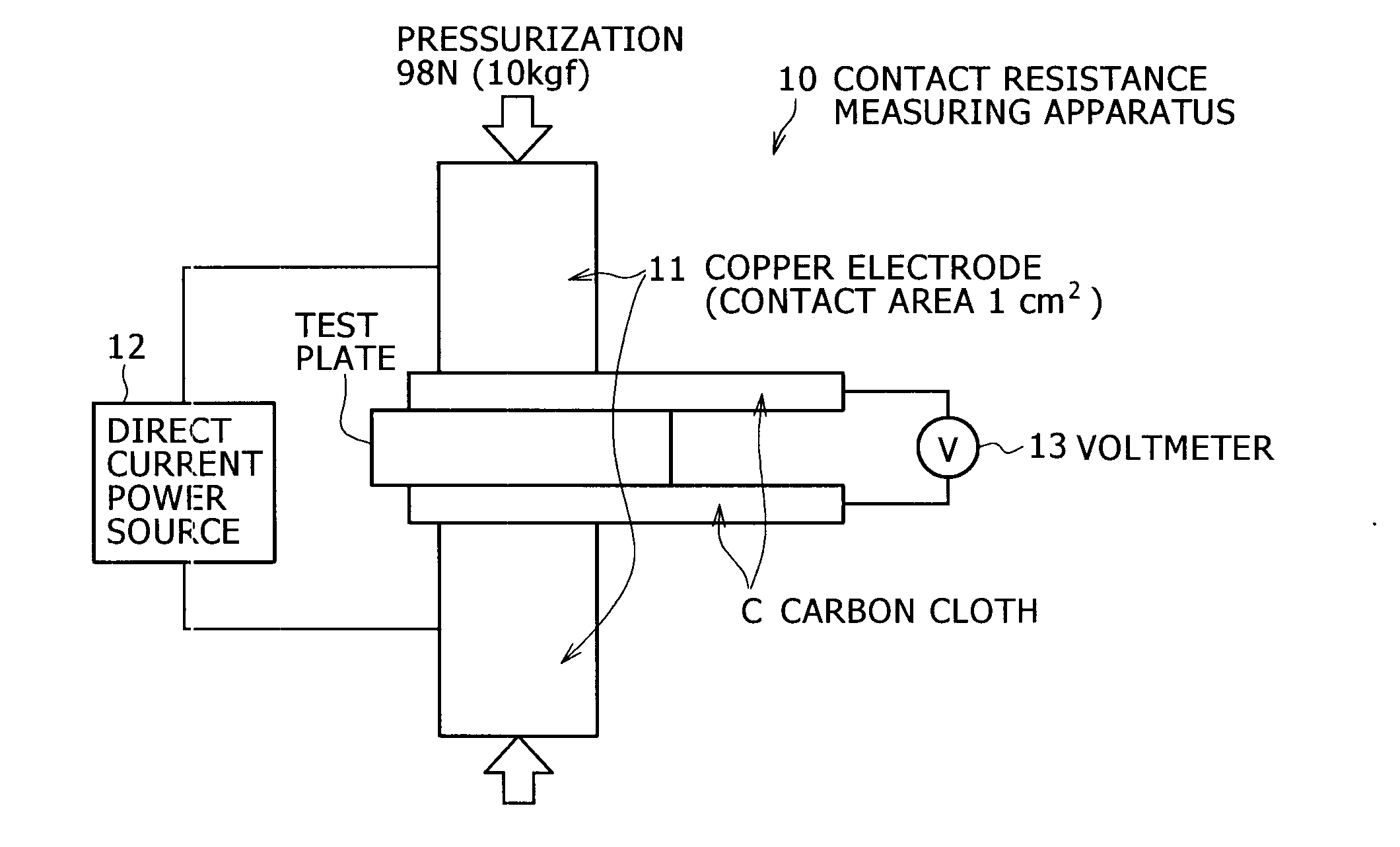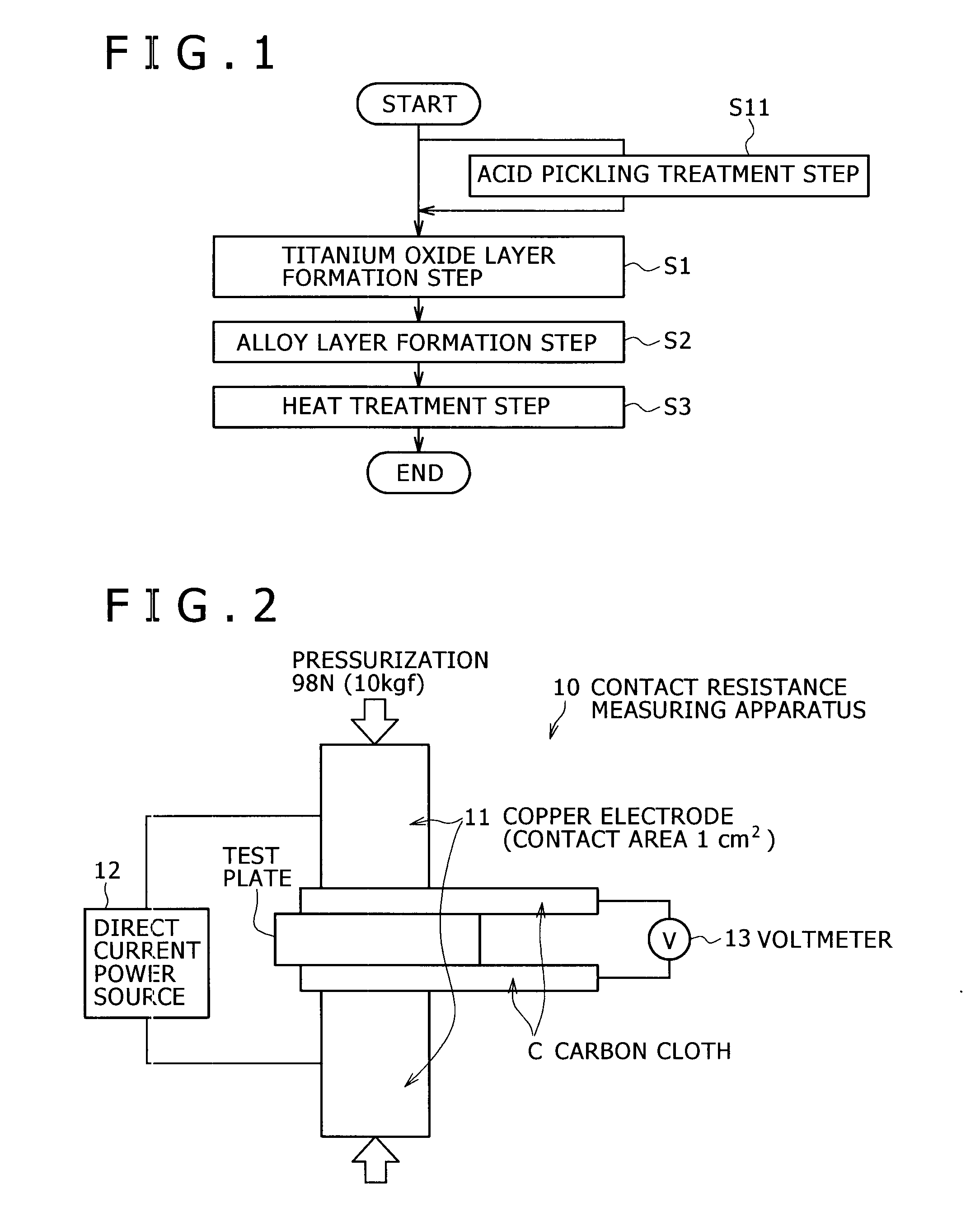Titanium electrode material and surface treatment method of titanium electrode material
a titanium electrode material and surface treatment technology, applied in the field of titanium electrode materials, can solve the problems of high corrosive formic acid formation, corrode stainless steel or titanium, and corrode the base material therefrom, and achieve and hydrogen absorption resistance. , excellent electric conductivity, corrosion resistance and hydrogen absorption resistan
- Summary
- Abstract
- Description
- Claims
- Application Information
AI Technical Summary
Benefits of technology
Problems solved by technology
Method used
Image
Examples
examples
[0073]Below, Examples in which the effects of the present invention were observed will be described as compared with Comparative Examples not satisfying the requirements of the present invention.
first embodiment
[0074]In a First Embodiment, the effects of the components / composition, and film thickness of an alloy layer formed on a titanium base material subjected to a heat treatment in an air atmosphere as the titanium oxide layer formation step S1 were evaluated.
[0075](Surface Treatment of Test Plate)
[0076]A test plate used was treated in the following manner. A titanium base material (width 2 cm×length 5 cm×thickness 0.2 mm) including class 1 pure titanium specified according to JIS H 4600 was subjected to ultrasonic washing in acetone as the acid pickling treatment step S11. Then, the titanium base material was subjected to an acid pickling treatment in a mixed aqueous solution of 1 mass % hydrofluoric acid and 5 mass % nitric acid, was washed with pure water, and was dried. Then, as the titanium oxide layer formation step S1, a heat treatment was carried out in an air atmosphere at 500° C. for 3 minutes. The thickness of the titanium oxide layer formed on the heat-treated test plate sur...
second embodiment
[0089]In Second Embodiment, there was evaluated the effect of the heat treatment temperature of a titanium electrode material on which a heat treatment in an air atmosphere had been performed as the titanium oxide layer formation step S1.
[0090](Surface Treatment of Test Plate)
[0091]In the same manner as in First Embodiment, a titanium base material (width 2 cm×length 5 cm×thickness 0.2 mm) including class 1 pure titanium specified according to JIS H 4600 was subjected to ultrasonic washing in acetone as the acid pickling treatment step S11. Then, the titanium base material was subjected to an acid pickling treatment in a mixed aqueous solution of 1 mass % hydrofluoric acid and 5 mass % nitric acid, was washed with pure water, and was dried. Then, as the titanium oxide layer formation step S1, a heat treatment was carried out in an air atmosphere at 500° C. for 3 minutes. The thickness of the titanium oxide layer was measured by a TEM in the same manner as in First Embodiment, and wa...
PUM
| Property | Measurement | Unit |
|---|---|---|
| thickness | aaaaa | aaaaa |
| thickness | aaaaa | aaaaa |
| thickness | aaaaa | aaaaa |
Abstract
Description
Claims
Application Information
 Login to View More
Login to View More - R&D
- Intellectual Property
- Life Sciences
- Materials
- Tech Scout
- Unparalleled Data Quality
- Higher Quality Content
- 60% Fewer Hallucinations
Browse by: Latest US Patents, China's latest patents, Technical Efficacy Thesaurus, Application Domain, Technology Topic, Popular Technical Reports.
© 2025 PatSnap. All rights reserved.Legal|Privacy policy|Modern Slavery Act Transparency Statement|Sitemap|About US| Contact US: help@patsnap.com


